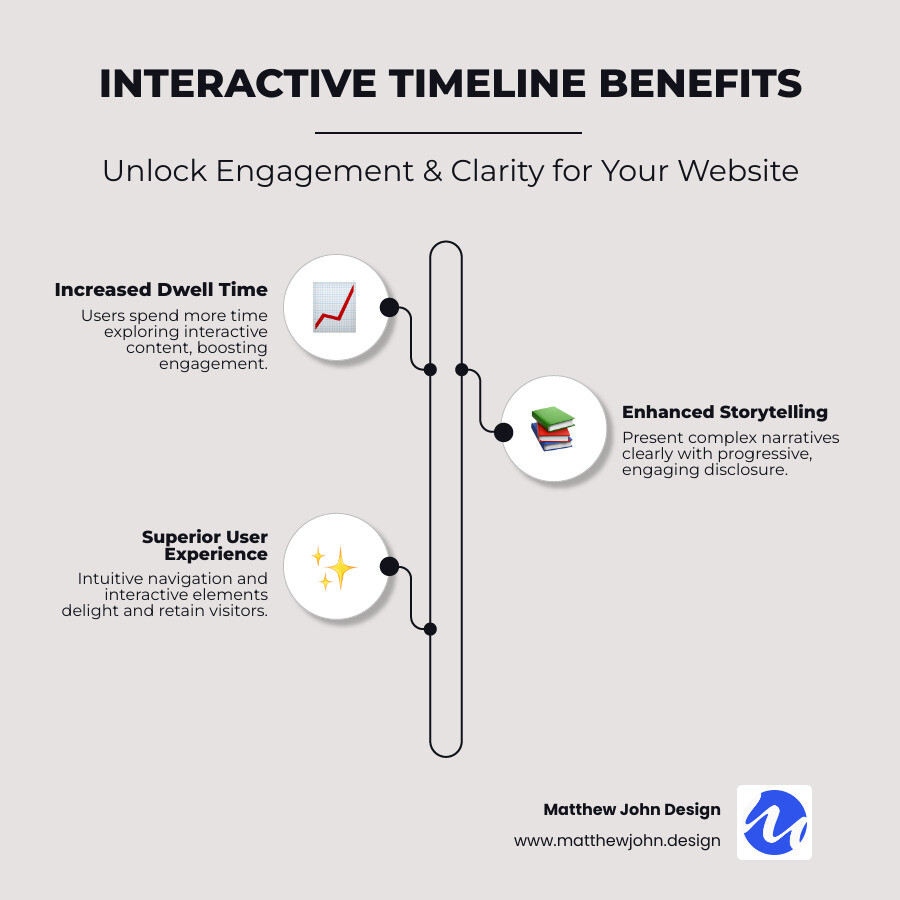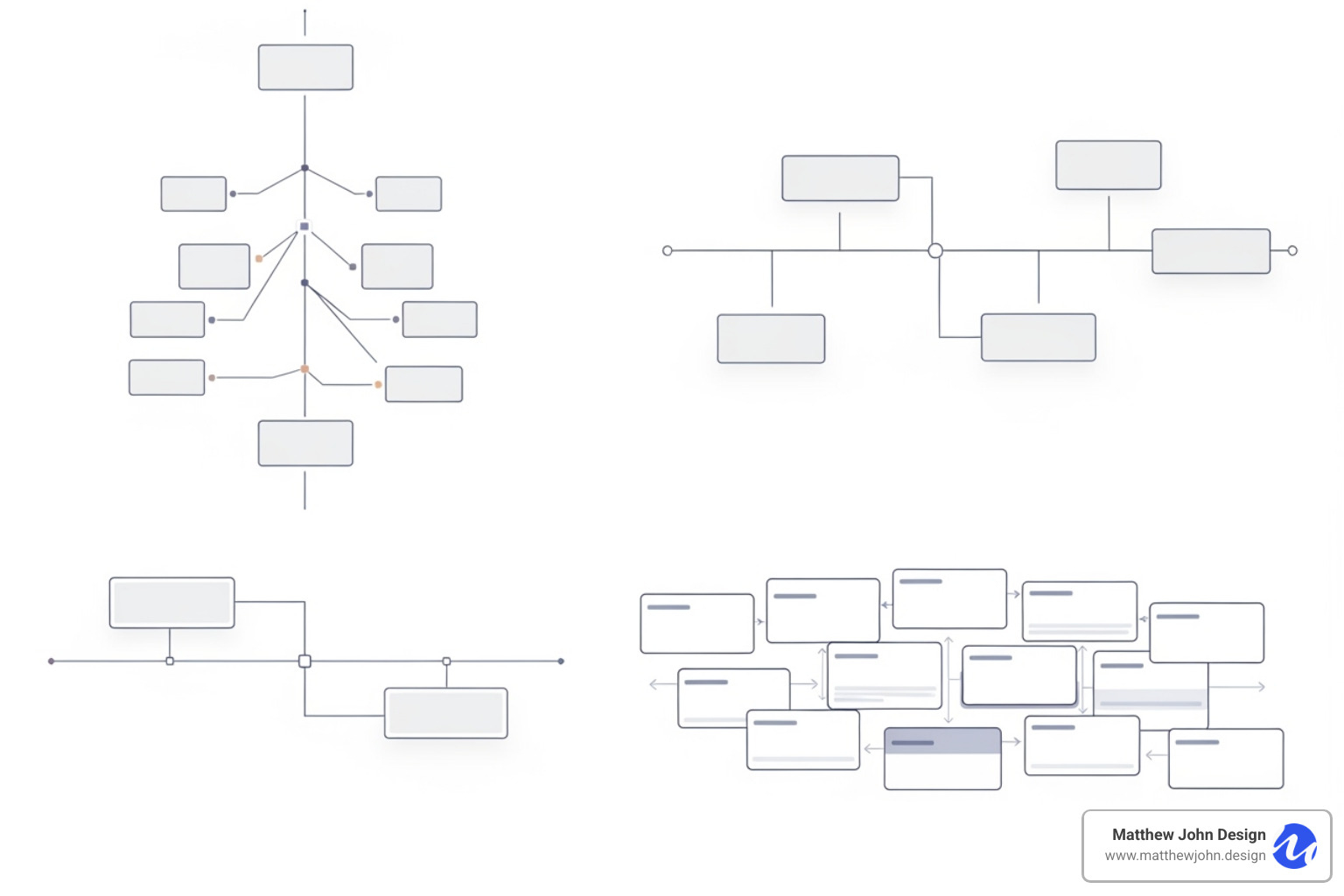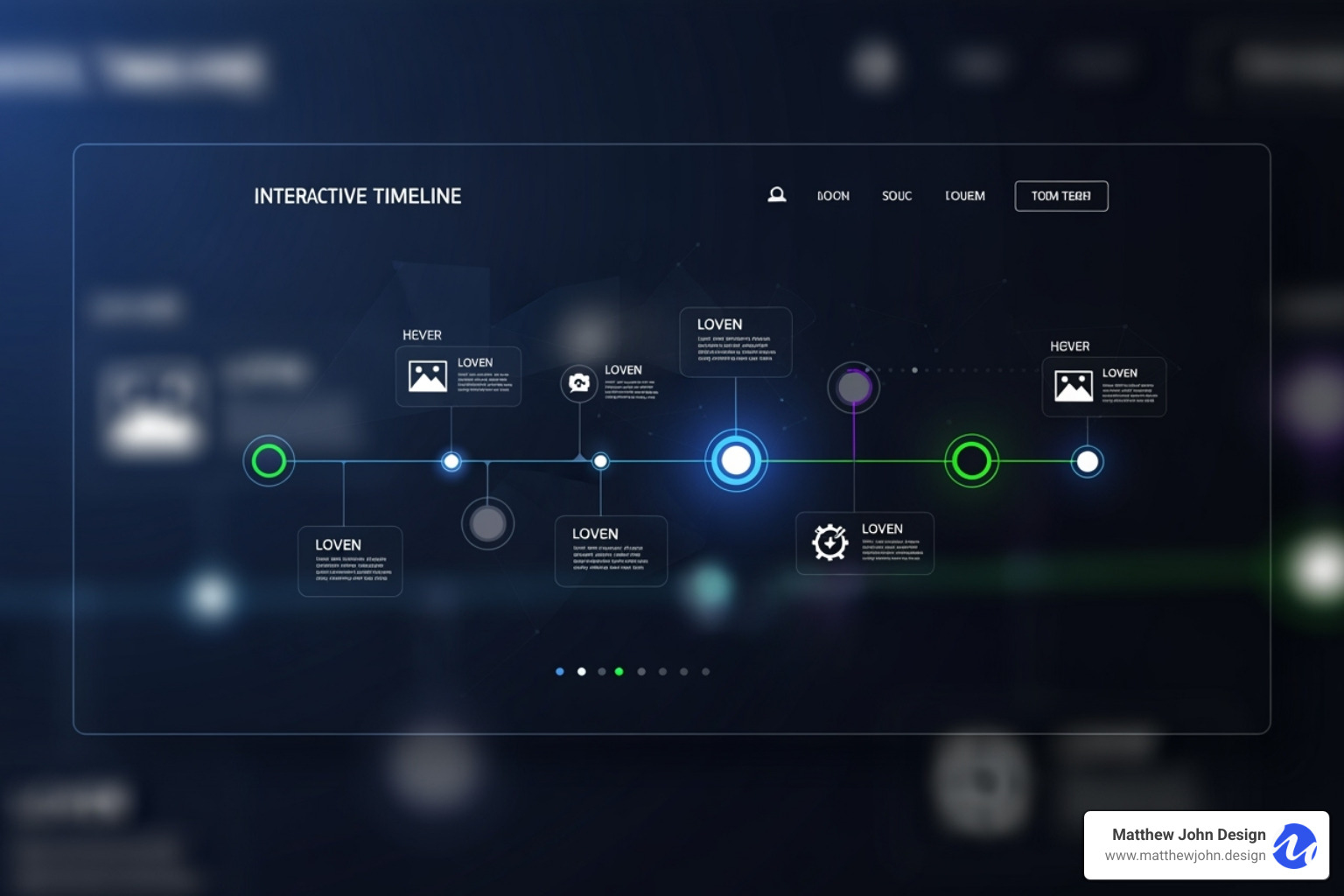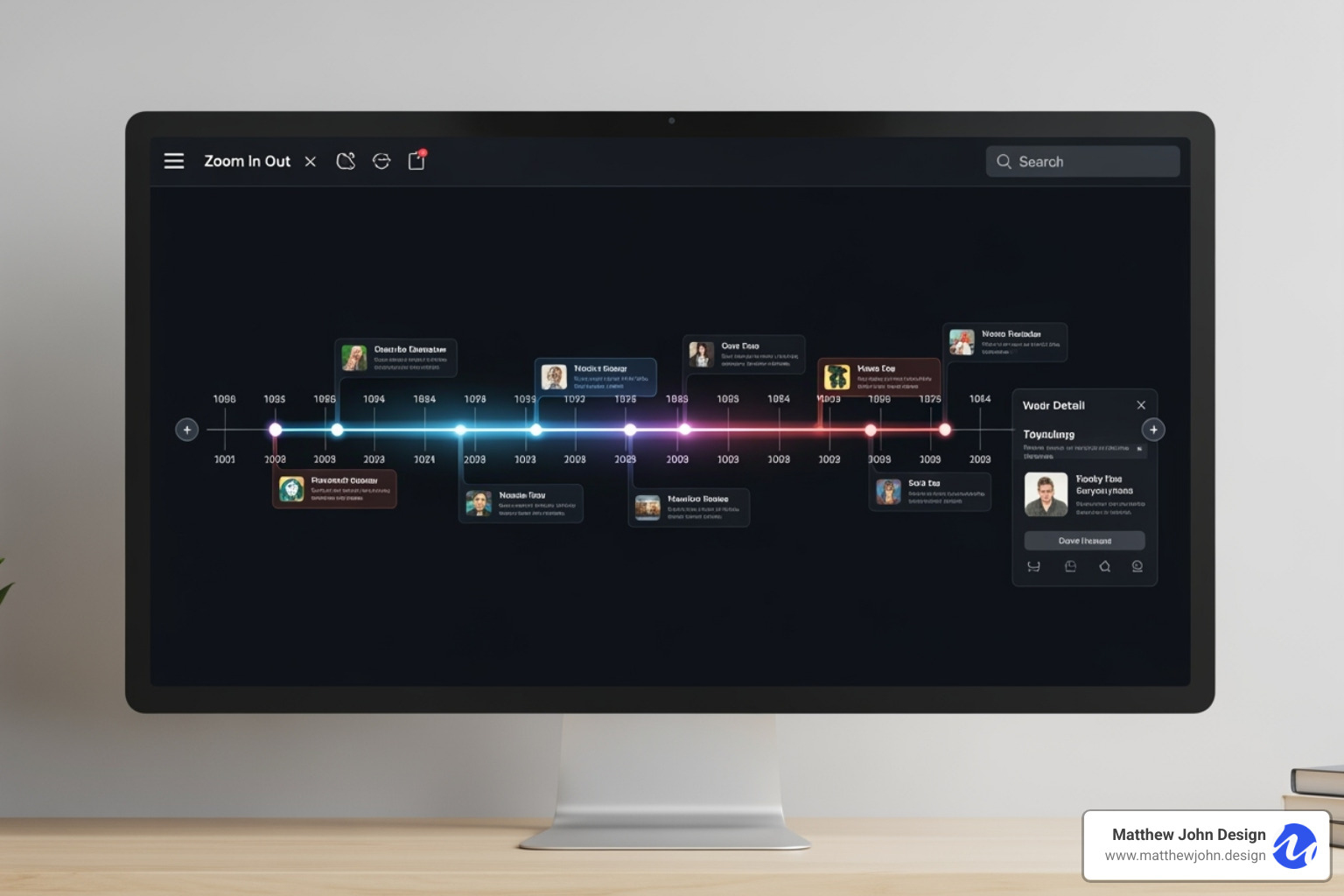Any information contained on this Website is not legal advice and should not be treated as such. You should always contact an attorney for help with your specific legal needs and issues. We may also earn a commission when you click links to our partners and purchase goods or services. For more information, read our Disclaimers Policy.
What is an Interactive Timeline and Why Your Website Needs One
Design for website interactive timeline starts with understanding what makes these digital storytelling tools so powerful for modern businesses.
Quick Answer for Interactive Timeline Design:
- Definition: Dynamic visual representations that users can click, scroll, and explore
- Key Elements: Timeline bar, clickable events, hover effects, embedded media, responsive layout
- Main Benefits: 3x higher user engagement, improved storytelling, better information retention
- Best Formats: Vertical (expandable content), horizontal (concise stories), card-based (rich media)
- Essential Features: Scroll animations, pop-ups, filters, mobile responsiveness
An interactive timeline transforms static information into an engaging journey that users want to explore. Unlike traditional timelines that simply list events, interactive versions invite visitors to click, hover, and find content at their own pace.
This approach solves a critical problem for business websites: information overload. Instead of cramming everything onto one page, interactive timelines reveal details progressively. Users stay engaged longer because they control their experience.
The data backs this up. Websites with interactive elements see 3x higher dwell time compared to static pages. For businesses, this translates directly to better brand recall and higher conversion rates.
Interactive timelines work particularly well for:
- Company histories that build trust and credibility
- Product roadmaps that showcase innovation
- Process explanations that simplify complex workflows
- Project showcases that demonstrate expertise
The key is choosing the right format and interactive elements for your specific story and audience needs.

Design for website interactive timeline vocab to learn:
Step 1: Planning Your Narrative Before You Design
Think of creating a design for website interactive timeline like directing a movie. You wouldn't start filming without a script, and you shouldn't start designing without a clear story. The most stunning interactive elements in the world can't save a timeline that doesn't know what it's trying to say.

Define Your Story
Every compelling timeline starts with a simple question: what story are you telling? Maybe it's how your startup grew from a garage idea to a thriving business. Or perhaps it's the evolution of your product from concept to market leader. Whatever it is, get crystal clear on your narrative before you touch a single design element.
Your story needs three key ingredients. First, define your purpose. Are you trying to educate visitors about your company history? Build trust by showcasing your expertise? Or maybe explain a complex process in digestible chunks?
Next, know your audience inside and out. A timeline for potential investors will look completely different from one designed for your customers. Consider their existing knowledge, attention span, and what they're hoping to learn.
Finally, nail down your key message. What's the one thing you want people to remember after exploring your timeline? Every event, every interaction should support this central theme.
Gather Assets
Your timeline is only as strong as the content that fills it. Start collecting everything you'll need before you begin designing. High-quality visuals make or break user engagement, so prioritize photos, videos, and graphics that tell your story powerfully.
For videos, Webflow only supports background videos up to 30 MB. For anything larger, you'll want to use third-party hosting like YouTube, Vimeo, or Vidzflow to keep your timeline running smoothly.
Text content should be concise and scannable. Interactive timelines excel at revealing information progressively through hover effects and pop-ups, so write with that in mind. Think bite-sized chunks rather than lengthy paragraphs.
Don't forget about data accuracy. Double-check dates, verify facts, and make sure everything flows chronologically. Nothing kills credibility faster than a timeline with incorrect information.
Assign Content Roles
Even if you're a team of one, thinking about content roles helps ensure nothing falls through the cracks. Someone needs to verify accuracy of all dates and facts. Another person should focus on narrative flow, making sure the story makes sense from start to finish.
Visual integration is equally important. Your images and text need to work together seamlessly, not compete for attention.
Set Clear Goals
What does success look like for your timeline? Maybe you want visitors to spend more time on your site, or you're hoping to increase conversions on your services page. Perhaps you want people to better understand your company's journey or feel more confident in your expertise.
Define measurable goals upfront. This makes it much easier to evaluate whether your timeline is actually working once it's live.
Chronological Flow
While timelines are naturally chronological, consider how users will steer through time. Will they scroll through linearly, or jump to specific periods that interest them? Both approaches work, but the choice affects your entire design strategy.
Keep user experience principles at the heart of your design for website interactive timeline. Your navigation should feel intuitive, your visual hierarchy should guide attention naturally, and users should always know what they can click or interact with.
For a deeper understanding of creating exceptional user experiences, check out The 5 Elements of User Experience. These principles will guide every decision you make as you bring your timeline to life.
Step 2: A Practical Guide to Design for Website Interactive Timeline
Now that we've laid the groundwork with solid planning, it's time to get into the nuts and bolts of design for website interactive timeline. This is where your narrative truly comes to life through visual appeal and engaging interactivity.

Choosing the Right Format for Your Story
The format of your interactive timeline isn't just an aesthetic choice; it's a functional one that dictates how your story unfolds and how users interact with it. Different stories lend themselves beautifully to different layouts.
For those long, flowing narratives with many events or detailed descriptions, vertical timelines are a fantastic choice. Think of them for company histories, biographical journeys, or extensive historical periods. They're often easier to expand with new content over time without disrupting the overall flow, as users simply scroll down to reveal more.
If you have a more concise story or want to emphasize progression across a single line, horizontal timelines are ideal. Project roadmaps or product launches often benefit from this format. They can be particularly striking when combined with scroll-triggered animations that move horizontally as the user scrolls vertically, adding an extra layer of engagement.
Then there are card-based layouts, which present each event as a distinct "card" – often with an image, headline, and a brief description. Users can click on a card to reveal more details. This is excellent for rich media content and for breaking down complex information into manageable, visually appealing chunks. It prevents clutter and allows you to "hide" larger amounts of text until the user wants to see it.
While less common for strict chronological timelines, a masonry style layout, similar to card-based but with an irregular grid, optimizes space. It can be adapted for thematic timelines where the exact order is less critical than the collection of events itself. And for the more business-oriented, Gantt charts visualize tasks against time, and interactive versions allow users to expand tasks and track progress, making them highly functional for project management.
The 'right' format depends entirely on your unique content and goals. We carefully consider how each option impacts clarity and user engagement to ensure your story shines.
Key Principles for an Effective Website Interactive Timeline Design
Regardless of the format you choose, certain design principles are universal for creating an effective and visually appealing design for website interactive timeline:
First, visual hierarchy is key. You want to subtly guide your users' eyes. Use variations in size, color, and placement to highlight the most important dates, events, or milestones. The main timeline bar, event markers, and pop-up details should all have a clear visual relationship, making navigation intuitive.
Don't be afraid of white space! It’s your friend. Empty space helps prevent screen clutter, improves readability, and makes your design feel clean and professional. Interactive timelines, by nature, can become quite dense, so strategic use of white space is crucial to avoid overwhelming your audience.
Next, consider your typography. Choose legible fonts that align perfectly with your brand. Use consistent font sizes and styles for headlines, descriptions, and labels. Good typography not only improves readability but also contributes significantly to the overall aesthetic and professional feel of your timeline.
Brand consistency is non-negotiable. Your timeline should feel like an integrated part of your website, not a standalone element. Maintain your brand's color palette, typography, and overall visual style. This reinforces your brand identity and creates a cohesive, trustworthy user experience.
Finally, and perhaps most importantly in today's digital world, your timeline must feature responsive design. This isn't just a nice-to-have; it's a must. Your interactive timeline must look and function beautifully on all devices – desktops, tablets, and mobile phones. Events should re-arrange gracefully, text should resize appropriately, and all interactive elements should remain easily accessible regardless of screen size. At Matthew John Design, we specialize in ensuring our Webflow sites are perfectly responsive, adapting gracefully to every device. For more insights on crafting engaging web experiences, check out our article on Creative Interactive Web Design.
Essential Interactive Elements to Boost Engagement
The "interactive" in interactive timeline is where the magic truly happens! These elements transform a static display into a dynamic, user-driven experience that keeps visitors hooked:
Hover effects are simple yet incredibly effective. When a user hovers over an event marker or a card, a brief tooltip or a subtle animation can appear, providing a hint of information or a delightful visual cue. This encourages exploration without overwhelming the user upfront.
At the core of interactivity are clickable events. Users click on an event to reveal more detailed information, often in a pop-up window or a dedicated detail panel. This allows you to present "bite-sized information" initially and then provide deeper context upon user request, giving them control over their journey.
Speaking of more detail, pop-ups or modals are fantastic. When a user clicks an event, a pop-up can display extended text, images, videos, or even embedded maps. This is excellent for managing information density, effectively creating "more real estate out of a smaller design" and keeping the main timeline clean.
Scroll-triggered animations add a sense of progression and dynamism. As users scroll down (or across) the timeline, events can neatly animate into view, lines can draw themselves, or elements can subtly shift. This makes the journey itself more engaging and memorable.
To truly enrich the experience, don't forget embedded media. You can integrate videos, audio clips, image galleries, and even interactive maps directly within your event details. A quick note on videos: while Webflow is fantastic, its native support is for background videos up to 30 MB. For larger video files, we always recommend using third-party hosting solutions like YouTube, Vimeo, or Vidzflow to ensure smooth performance and a seamless user experience.
For timelines with many events or diverse topics, filters and categories are a lifesaver. Allowing users to filter by category, date range, or keyword empowers them to quickly find the information most relevant to them, significantly enhancing usability. And a subtle progress indicator – a small bar or visual cue – can show users how far they’ve moved through the timeline, which is especially helpful for longer narratives.
By carefully selecting and implementing these interactive elements, we can transform a simple chronological list into a captivating digital storytelling experience that truly engages your audience.
Step 3: Bringing Your Timeline to Life: Tools and Implementation
Once the planning is complete and your design vision is sparkling clear, the big question pops up: how do we actually build this amazing interactive timeline? Well, you've got a couple of exciting paths ahead, each with its own perks.
Approaches to Building Your Interactive Timeline
When it comes to crafting your digital story, you can often choose between a "do-it-yourself" approach with handy no-code tools or opting for a custom-built solution. Your best bet usually depends on how complex your story is, your budget, and how much unique control you want.
For those who love to create quickly without diving into code, no-code platforms are a fantastic place to start. Think of them as your digital craft kits! You've got tools like Canva's Online Timeline Maker, famous for its super easy drag-and-drop interface. It's great for making eye-catching visuals of events or processes, offering lots of templates and customization options. Then there's Genially's Interactive Timeline Maker, which really pushes the idea that an "interactive timeline is a lot more engaging than a simple linear diagram." They offer ready-made templates where you can easily pop in videos, sounds, and maps. And don't forget TimelineJS, a clever open-source tool that lets anyone build rich, interactive timelines just by using a Google Spreadsheet! It updates automatically and supports tons of media. While these tools are fast and budget-friendly, they might sometimes feel a bit limited if your vision is truly unique, potentially leading to "frustrating compromises" for complex ideas.
Now, if you're dreaming of a truly one-of-a-kind, deeply integrated design for website interactive timeline that shouts your brand's personality, then custom design and development is your perfect match. This is where expert web design teams, like us at Matthew John Design, step in. We can craft a timeline that's not just beautiful, but also perfectly custom. This means you get Unique Branding that blends seamlessly with your website, Advanced Interactivity with complex animations and clever filtering systems, and Scalability built to grow effortlessly with your content. Plus, we focus on Performance Optimization so your timeline loads super fast, and SEO Integration to make sure search engines love your valuable content.
Here's a quick peek at how these two approaches stack up:
| Feature | No-Code Tools (e.g., Canva, Genially, TimelineJS) | Custom Design & Development (e.g., Webflow with custom code) |
|---|---|---|
| Customization | Limited to templates and pre-set options | Full control over design, layout, and functionality |
| Interactivity | Basic hover, click, and media embeds | Advanced animations, dynamic filtering, complex user flows |
| Scalability | Can become cumbersome with large datasets | Built to handle extensive and growing content efficiently |
| Branding | Often generic or requires manual adaptation | Seamlessly integrated with existing brand guidelines |
| Cost | Lower initial cost, subscription fees | Higher initial investment, but greater long-term value |
| Complexity | Best for straightforward timelines | Ideal for intricate narratives and unique user experiences |
Building a Custom Website Interactive Timeline Design in Webflow
At Matthew John Design, we're big fans of Webflow, and for good reason! It's an absolute powerhouse for creating stunning, custom interactive timelines. Webflow lets us bring together beautiful design with clever interactions and smart content management.
Webflow's native interaction engine is incredibly powerful. We can make your timeline come alive with Dynamic Scrolling Effects, where events gracefully appear as users scroll, or even horizontal movements triggered by vertical scrolling. Imagine subtle Hover Animations that hint at more information, or Clickable Events with Modals that pop up detailed info, images, or videos when clicked. We can even add Progress Indicators to show users how far they've come on their journey. Webflow truly lets us "design and develop custom Webflow interactions that bring your website to life," making for a truly immersive experience.
For timelines with lots of events or content that needs regular updates, Webflow's Content Management System (CMS) is a dream come true. We can structure all your timeline data – like dates, titles, descriptions, and images – right within the CMS. This means your marketing team can easily add, edit, or remove timeline events without ever touching the design or code. The timeline then automatically pulls in the content, ensuring everything is consistent and updates are incredibly efficient. This is how we empower internal marketing teams for "efficient ongoing management."
We also build our Webflow sites using Scalable Component-Based Systems. This means that elements, like a "timeline event card" or a "navigation arrow," are designed as reusable building blocks. So, if you decide to add more events down the road or want to tweak the design of all your timeline entries, we can update that single component, and the changes apply everywhere! This makes your design for website interactive timeline not just beautiful, but also super easy to maintain and flexible for future growth.
While Webflow offers amazing built-in features, sometimes a project needs something truly unique, like advanced filtering or specific chart visualizations. In those cases, we can easily extend Webflow's capabilities by Integrating Third-Party Scripts or custom code directly into your project. For instance, advanced features like an admin view with a drag-and-drop system for reordering timeline elements can be built using custom JavaScript and Webflow's powerful API. This allows us to meet virtually any interactive requirement you can imagine!
To learn more about how we use Webflow to create compelling online experiences, check out our insights on Webflow Interactive Websites.
5 Inspiring Interactive Timeline Examples
Nothing beats seeing great design for website interactive timeline examples in action. These real-world implementations show how different organizations use interactive timelines to tell compelling stories and engage their audiences.

1. Company History: Building Brand Credibility Through Time
Company history timelines are incredibly effective for building trust and emotional connection with your audience. Think about how powerful it would be to showcase your company's journey from humble beginnings to industry leader through an interactive experience.
Each major milestone becomes a clickable event. Users might hover over your first product launch to see a quick stat, then click to open a modal with archival photos, founder quotes, or even a short video clip. This approach transforms dry corporate history into an engaging narrative that builds credibility and helps visitors understand your brand's values and evolution.
The beauty of this format is how it lets users explore at their own pace. Some visitors want the quick overview, while others love diving into the details of how you overcame early challenges or achieved breakthrough moments.
2. Historical/Educational: The Anne Frank House Timeline
When it comes to educational storytelling, the Anne Frank House website sets the gold standard. Their interactive timeline guides visitors through Anne Frank's life and the broader historical context of World War II with remarkable sensitivity and depth.
Users can steer through different years, click on specific events to read detailed accounts, view historical photos, and watch documentary footage. What makes this timeline truly exceptional is how it presents complex, sensitive history in an accessible way while allowing users to engage as deeply as they choose.
This example demonstrates how design for website interactive timeline can create profound educational experiences that go far beyond what static content could achieve. You can explore this powerful example of historical storytelling from the Anne Frank House.
3. Product Journey: Showcasing Innovation Over Time
Product evolution timelines are perfect for highlighting innovation and building anticipation for future releases. Imagine tracking the development of a groundbreaking product from concept to current version.
Each iteration becomes an interactive point where users can explore design changes, new features, and technological breakthroughs. Clicking on an early version might reveal the challenges overcome, while selecting the latest model showcases cutting-edge capabilities.
This format works particularly well for technology companies, but any business with evolving products or services can use this approach to demonstrate growth, innovation, and continuous improvement to their customers.
4. Personal Story: Creating Emotional Connections
Personal narrative timelines excel at building authentic connections between individuals and their audiences. Whether it's a musician's career journey, an entrepreneur's path to success, or a founder's story, these timelines make abstract achievements feel personal and relatable.
Interactive elements bring these stories to life in ways traditional biographies cannot. A musician's timeline might include audio snippets from different albums, photos from memorable performances, or videos from career-defining moments. Each click reveals another layer of the person's journey, creating a deeper emotional connection with the audience.
5. Project/Report: Denver Interactive Timeline
The Denver Interactive Timeline showcases how creative interaction design can transform historical presentation. This timeline uses a brilliant horizontal scrolling experience triggered by vertical scrolling, making the exploration of Denver's history feel like a journey through time itself.
As users scroll down the page, the timeline moves sideways, revealing different eras from "Geologic Time" to "Modern Denver." This unique interaction method demonstrates how design for website interactive timeline can leverage innovative scroll effects to guide users through extensive content while keeping them engaged throughout the experience.
What makes this example particularly effective is how the scrolling mechanism feels natural and intuitive, even though it's doing something unexpected. Users instinctively understand how to steer, but the experience feels fresh and memorable.
These examples show the versatility of interactive timelines across different industries and purposes. From building brand credibility to educating audiences and showcasing innovation, interactive timelines transform passive viewing into active exploration. The result is higher engagement, better information retention, and more meaningful connections with your audience.
For more inspiring work and creative approaches to web design, browse our Portfolio.
Conclusion: Start Building Your Timeline Story Today
Phew, what a journey we've been on! We've explored the fascinating world of design for website interactive timeline, from understanding just how powerful they can be for your online presence, to the crucial steps of planning your unique story. We've talked about picking the perfect format, adding those delightful interactive touches, and finally, bringing it all to life with amazing tools like Webflow.
An interactive timeline isn't just a pretty picture. It's a dynamic stage for your stories! These timelines truly captivate your audience, making even complex information easy to grasp. They help you build deeper connections with your brand. Think of them as your secret weapon against information overload, serving up content in bite-sized, engaging pieces. This means visitors stick around longer and truly absorb your message. Whether you're sharing your company's rich history, showing off a product's cool evolution, or simply explaining a tricky process, an interactive timeline turns a passive glance into an active, memorable experience.
Here at Matthew John Design, crafting these compelling digital narratives is what we do best. Our special touch lies in building Webflow sites with smart, scalable components. This means you get a stunning interactive experience, and your own internal marketing team can easily manage and update content down the road. We truly understand the ins and outs of design for website interactive timeline. We know how to weave them seamlessly into your existing website, making sure they look fantastic, work flawlessly, and perform beautifully on any device.
So, why let your amazing stories just sit there? It's time to bring them to life and engage your audience in a whole new way. If you're ready to transform your content into an unforgettable interactive journey, we're here and excited to help. Let's get a custom interactive website designed and developed that truly tells your story.

